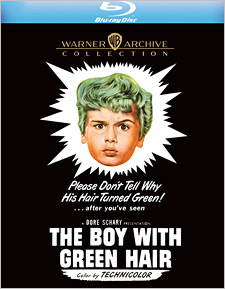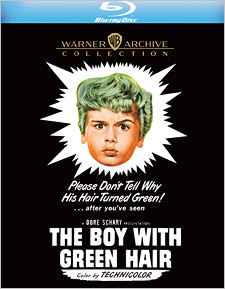Boy with Green Hair, The (Blu-ray Review)

Director
Joseph LoseyRelease Date(s)
1948 (May 30, 2023)Studio(s)
RKO Radio Pictures (Warner Archive Collection)- Film/Program Grade: B+
- Video Grade: A
- Audio Grade: A-
- Extras Grade: B-
Review
The Boy with Green Hair (1948) is like nothing else made by Hollywood in the 1940s, maybe nothing like any American studio-made picture ever. The only movie I can think of that’s even remotely similar is the long-forgotten Amazing Grace and Chuck (1987), more about which later.
Produced by RKO’s liberal head of production Dore Schary just as arch-conservative millionaire Howard Hughes was taking over the studio, the film was directed by Joseph Losey from a script co-written by Ben Barzman, both active in Communist Party USA. It’s a children’s film, a fantasy picture, and an allegorical message film all rolled into one, preachy yet murky simultaneously. Some of the time its images are as striking as the Technicolor Powell and Pressburger films; for much of it, though, the direction is clumsy and the camerawork ordinary. It’s a film of innumerable contradictions.
Peter Fry (Dean Stockwell) becomes a war orphan when his American parents are killed during the London Blitz while trying to evacuate children. He’s passed from relative to relative, finally ending up with Gramp (Pat O’Brien), an ex-vaudevillian now working as a waiter. Just as Peter is settling in at his latest home, overnight his hair inexplicably turns bright green.
Gramp, his schoolteacher Miss Brand (Barbara Hale, later of TV’s Perry Mason), and town sawbones Dr. Knudson (Samuel S. Hinds, Pa Bailey from It’s a Wonderful Life) are surprised but sympathetic toward Peter’s condition, but the rest of the town and Peter’s classmates become suspicious and cruel at this development, a big and little mob. What if he’s contagious? What if the milk Peter has been drinking is contaminated? Why does Peter look so...different? His former friends at school (including an unbilled Russ Tamblyn, in his feature debut) bully him, and the townsfolk pressure Peter to shave his head.
Peter, for his part, resents that his parents prioritized the children in London, strangers, above him, and for dying and leaving him to fend for himself. He becomes enraged looking at a series of posters promoting relief for war orphans, children that later come to life in the forest as spirits (?) who explain the meaning of Peter’s green hair.
The Boy with Green Hair has many exceptional qualities, but the overall impact of its story is muted if not confused. (Spoilers) Its basic concept is that Peter has been given green hair as a kind of attention-grabbing badge of honor in order to spread a message on behalf of war orphans around the world: “war is bad for children and all living things.” However, it’s a message clunkily presented. For one thing, the war orphans in the poster and which Peter sees again in the forest are still alive. Wouldn’t it have made more sense for Peter to represent dead children killed during the war? And, given that the reaction by the townspeople is so irrational, how could Peter possibly spread such his message when the intended recipients already feel so threatened by Peter’s appearance? Are Barzman and Losey being cynical, proactively implying that Americans aren’t ready to hear what Peter has to say?
The film seems designed to tell Peter’s story from his child perspective, but Barzman and Losey are all thumbs in this regard; later movies like Invaders from Mars (1953) and The Invisible Boy (1957) did this better. On the other hand, Dean Stockwell is excellent as Peter; he’s completely real even when much of what’s swirling around him is a clumsy polemic. Conversely, Pat O’Brien is subtly miscast, breezy and genial when he should be warm and empathetic; he’s just not in sync with the film’s aims. Albert Sharpe (of Darby O’Gill and the Little People) was considered; an actor like Arthur Shields would have been ideal. The unsureness of the production is evident in a strange fantasy scene, like something out of The 5,000 Fingers of Dr. T, when Peter imagines Granp entertaining a King (Walter Catlett). The film would have been better without it. Better is the framing story, with runaway Peter interviewed by sympathetic Dr. Evans (Robert Ryan). He’s really the only adult who talks to Peter at his level, whereas others, including his schoolteacher, hardly interact with him at all.
In a way, the timing of the film could not have been worse. Losey and Barzman were blacklisted soon after, and Hollywood became unquestioningly pro-military, pro-American virtually overnight. Pacifism in the late 1940s was likened to pro-Communist defeatism.
Yet, the film’s sincere if simplistic message (war is bad) was so unusual, like its title character The Boy with Green Hair certainly stands apart from the crowd. Only Amazing Grace and Chuck resembles it. In that film a young boy (Chuck), disturbed by nightmares of nuclear war, stops playing baseball causing his Little League team to lose an important playoff game. When local news stations pick up the story, a sympathetic NBA star (“Amazing” Grace) likewise stops playing basketball, and soon so many professional athletes join the walkout it brings professional sports to halt, causing an uproar. Later, all the children of the world stop speaking, forcing the U.S. President (Gregory Peck) to meet with Chuck, who started it all. I rather liked it the one time I saw it in the ‘80s, despite a clumsiness at times similar to The Boy with Green Hair. Film critics generally praised the older film but hated Amazing Grace and Chuck, unable to see past its mostly inconsequential flaws.
Warner Archive’s 4K remastering of The Boy with Green Hair sources the original black-and-white separation camera negatives of this 3-strip Technicolor production. The results, like the simultaneously released King Solomon’s Mines are impressive—the image is razor-sharp with no matrix bleeding and the color is luxuriously rich. The DTS-HD Master Audio (2.0 mono) is likewise excellent with minimal distortion. Optional English subtitles are included on this Region-Free disc.
Extras are limited to a trailer and a one-reel short subject (10:51) made by MGM starring Stockwell, A Really Important Person. It’s just okay though, again, Stockwell is good.
The Boy with Green Hair is a real curio, in some ways successful and in some ways much less so. But for its unusualness alone, coupled with Warner Archive’s superlative transfer, it’s definitely worth a look.
- Stuart Galbraith IV

